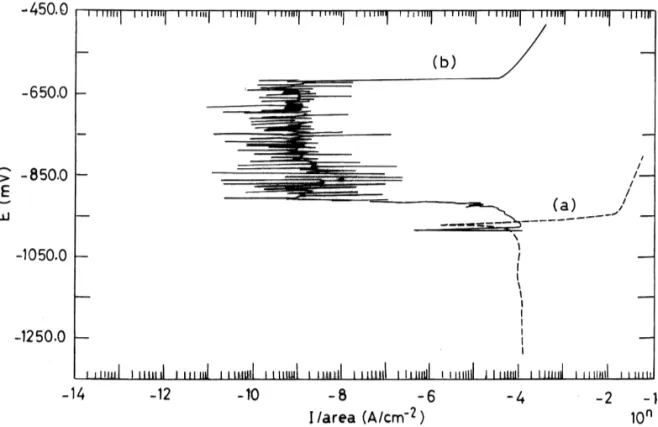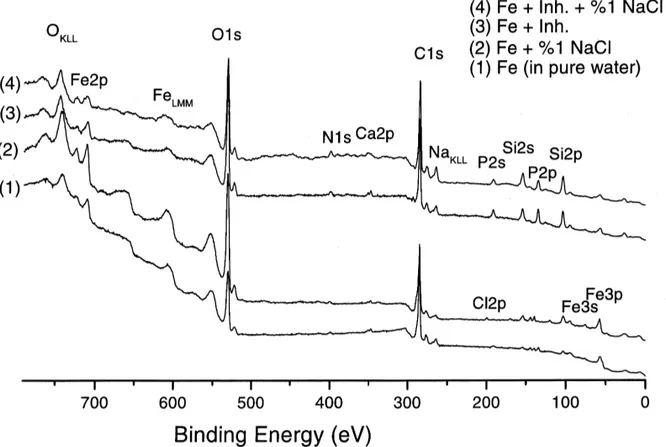www.elsevier.nl / locate / elspec
Electrochemical and XPS studies of corrosion behaviour of a low
carbon steel in the presence of FT2000 inhibitor
a b ,
*
F. Kadirgan , S. Suzer
a
Department of Chemistry, Istanbul Technical University, 80626 Istanbul, Turkey
b
Department of Chemistry, Bilkent University, Bilkent, 06533 Ankara, Turkey
Received 8 August 2000; received in revised form 6 September 2000; accepted 9 September 2000
Abstract
Corrosion behaviour of a new inhibitor (FT2000) is investigated in saline solution on a low carbon steel in the neutral aqueous media at 608C. Effect of sulphate ion is also studied. Corrosion rate, polarization resistance, and efficiency of the inhibitor are calculated. The nature of the protecting layer formed in the presence of the inhibitor is investigated by X-ray photoelectron spectroscopy, XPS. 2001 Elsevier Science B.V. All rights reserved.
Keywords: Corrosion inhibitor; Low carbon steel; XPS
1. Introduction ring at, in or through a surface oxide film [3]. The mechanism of action of inhibitive anions on the
Low carbon steel generally exhibits passive be- corrosion of Fe in near neutral solution involves the
haviour in neutral aqueous media and its corrosion is following important steps:
intimately connected with the properties of its
pas-sive surface oxide film [1,2]. Intenpas-sive corrosion is • Reduction of the dissolution rate of the
passivat-often observed due mainly to the aggressive prop- ing oxide film
erties of water which depend markedly on its hard- • Repair of the oxide film by promotion of the
ness. Water with high carbonate hardness is, as a reformation of oxide
rule, non-aggressive, but it facilitates deposition of • Repair of the oxide film by plugging pores and
scale on pipes and heat exchange equipment. Soft coat the surface by insoluble compounds
water does not give rise to deposit of scale, but it is • Prevention of the adsorption of aggressive anions
highly corrosive. On the other hand, corrosivity of the water is determined by its chloride and sulphate
It has been observed that inhibition of metal corro-contents for steel as well as by its hardness salts.
sion occurred only when the initial rate of dissolution Passive metals generally corrode by processes
occur-of metal oxides in solution occur-of anions was less than a critical value.
*Corresponding author. Tel.: 2664946; fax:
190-312-2664579. In this work, corrosion inhibition behaviour of
0368-2048 / 01 / $ – see front matter 2001 Elsevier Science B.V. All rights reserved. P I I : S 0 3 6 8 - 2 0 4 8 ( 0 0 ) 0 0 2 5 5 - 3
potentiostat–galvanostat system. Potentiodynamic passivating oxide, a halide possessing good solubility
cathodic and anodic polarization curves were mea- will also be formed. Pitting corrosion then sets in.
2 2
sured in 1% NaCl and 0.5% Cl 10.5% NO 10.5%3 This kind of corrosion can be suppressed with the aid
22
SO4 solutions with and without the inhibitor in air of an inhibitor, which is able to prevent the
ad-at 608C after immersion of the specimen for about 15 sorption of aggressive ions or to dislodge them from
min and after the open-circuit potential became the metal surfaces.
steady. The inhibitor (FT2000) contains organic and Corrosion parameters can be calculated on the
inorganic salts and was manufactured for use on basis of potentiodynamic potential–current
charac-some metals, such as Al, Cu, steel and brass in teristics in the Tafel region (E5Ecorr6250 mV) and
aqueous media. The pH of the solutions with inhib- in the vicinity of the corrosion potential (E5
itor was always kept between 7 and 7.5. A platinum Ecorr620 mV) according to:
electrode and a saturated mercury sulphate electrode
log j 5 log ja corr1 (E 2 Ej corr) /ba
were used as counter and reference electrodes. Corrosion rates of specimens per year and
polarisa-log j 5 polarisa-log j 1 (E 2 E ) /b
tion resistances were calculated from Tafel analysis c corr corr j c
[5]. Surface characterisation using XPS was
per-These equations corresponds to linear anodic and formed using a Kratos ES 300 spectrometer with
cathodic Tafel lines with slopes b 5 2.3RT /azF andc
Mg Ka X-rays (1253.6 eV).
b 5 2.3RT /(1 2 a)zF, where R5gas constant, z 5a
number of transferred electrons, a 5transfer
coeffi-cient, b 5anodic Tafel slope and b 5cathodic Tafela c
3. Results and discussions
slope. Current density ( jcorr) is determined by
ex-trapolating the Tafel lines to E 5Ecorror according to
A comparison of the corrosion potential of iron in
the Stearn–Geary equation [6]. This results in: neutral electrolytes, with the potentials for iron-oxide
formation, indicates that for even just a slight shift in j 5 b ? b / 2.3(b 1 b ) R 5 B /R
corr a c a c p p
the potential to the positive side of the steady-state
value, there will take place an oxidation reaction. where R is the polarisation resistance, defined as thep
Since this reaction is electrochemical for anodic tangent of the curve at Ecorr.
polarization it will be accelerated, just like the
R 5 (dE / dj )p E 5E
ionization of the metal. The more positive the corr
potential becomes, the greater will be the blanketing
Once jcorr is known, corrosion rate can be calculated
of the electrode with the oxide. When the passivation
using the conversion formula: potential is reached, the electrode will almost be
Fig. 1. Tafel plots of Fe in 1% NaCl without (a) and with (b) the addition of the inhibitor at 608C.
where EW is the equivalent weight of the sample in are listed in Table 1. Determination of Rp was
2
g, A is the sample area in cm , d is the density in carried out in the vicinity of Ecorr with a sweep of
g / ml, and C is a conversion constant that is depen- 0.1 mV/ s. The inhibiting efficiencies calculated using
3
dent upon the units desired. C is 3.268310 when the equation:
jcorr is in amperes and corrosion rate is desired in
e 5 (1 2 j /j )
millimeters per year. corr,i corr
Fig. 1 shows the Tafel plots of Fe in 1% NaCl
without and with the addition of the same inhibitor. where, jcorr, jcorr,i, Rp and Rp,i are the corrosion
Results for Ecorr, jcorr and the Tafel constants current densities and the polarization resistances
calculated from E 2 log j curves obtained in the without and with inhibitor, respectively.
uninhibited and the inhibited NaCl solution at 608C As it is seen from Fig. 1, for steel in 1% NaCl
Table 1
Corrosion parameters, inhibition efficiencies obtained by Tafel analysis and polarization resistances of the low carbon steel without and with the addition of the inhibitor at 608C
Solution Ecorr jcorr bc ba e Corrosion rate Rp
2
(mV/ MSE) (mA / cm ) (mV) (mV) (mm / year) (V)
23 1% NaCl 2975.8 115.9 303 60.3 – 914.2310 52.18 23 26 1% NaCl1inh. 2918 150.4310 – 284 0.998 1.2310 184.00 0.5% NaCl1 23 0.5% Na SO2 4 2930 92.3 300 62.3 – 502310 18.2 0.5% NaCl1 23 27 0.5% Na SO 1inh.2 4 2790 38.1310 104 414 0.999 3310 95.3
the potential to the more positive values, the anodic So, the adsorption of activated ion is excluded on
current increases. However, the values are smaller steel in the presence of the inhibitor depositing
than the currents obtained without the inhibitor phosphate and silicate layer from electrolyte while
media. The resistance polarization also increases in the passivating oxide appears due to the interaction
the presence of the inhibitor. Using the 0.5% NaCl1 of the metal with oxygen. In the presence of
phos-0.5% Na SO as corrosive electrolyte, even a higher2 4 phates, it is observed that, there are two passivation
inhibitor efficiency is observed. potentials on the anodic polarization curve: one of
Fig. 2. XPS spectra of steel samples immersed (1) in pure water, (2) in a 1% NaCl saline solution, (3) in a solution containing only the inhibitor, (4) in a 1% NaCl saline solution containing also the inhibitor.
these is shifted 0.2 V toward the negative in com- carbon steel. An increase of the polarization
resist-parison with the potential of ordinary passivation ance also proves the protective properties of the
observed in a without phosphate solution [8]. This inhibitor. Since the dissolution rate of this layer in
led to conclusion that in phosphate solutions the combination with calcium existing in water is low
transition of iron into the passive state is preceded by and the surface film have an exceptionally high
a specific passivation caused by the secondary resistance to the transfer of electrons, corrosion rate
deposition of metal phosphate from the solution. of the metal is decreased in the corrosive media.
Accumulation of a poorly soluble iron phosphate on Therefore, one can conclude that the oxide film of
the steel surface creates conditions favourable for steel is repaired by plugging pores and coated by
ordinary oxide passivation. insoluble compounds and adsorption of aggressive
Taking into consideration these properties of the anions is prevented.
oxide layer, we assume that in the presence of inhibitor, these phosphate layers are formed on the
sample. Two corrosion potentials observed may References
correspond to the formation of: (i) iron phosphate (at
ca. 20.99 V vs. MSE which is slightly negative than [1] P.A. Malachesky, in: A.J. Bard (Ed.), Encyclopedia of
Electrochemistry of the Elements, Vol. VI, Marcel Dekker,
without the inhibitor media), and (ii) complete
New York, 1976, p. 63.
passivation with iron oxide formation (at ca. 20.92
[2] M. Pourbaix (Ed.), Atlas of Electrochemical Equilibria in
V vs. MSE) in 1% NaCl solution. Aqueous Solutions, Pergamon Press, Oxford, 1966, p. 168.
[3] K.J. Vetter, Electrochim. Acta 16 (1971) 1923. [4] F. Kadirgan, Turkish patent (applied for).
[5] A.J. Bard, L.R. Faulkner, Electrochemical Methods, Wiley,
4. Conclusions
New York, 1980.
[6] K.J. Vetter, Electrochemical Kinetics, Academic Press, New
Based on the electrochemical and XPS data ob- York, 1967.
tained in the present study, protective and passivat- [7] D. Briggs, M.P. Seah, 2nd Edition, Practical Surface
Analy-ing properties of FT2000 inhibitor is observed. The sis, Vol. 1, Wiley, Chichester, 1996.
[8] I.L. Rozenfeld, Corrosion Inhibitors, McGraw-Hill, New
XPS spectra taken in immersed solutions for a
York, 1981.
certain time show the protective film formation containing phosphate and silicate ions on the low

